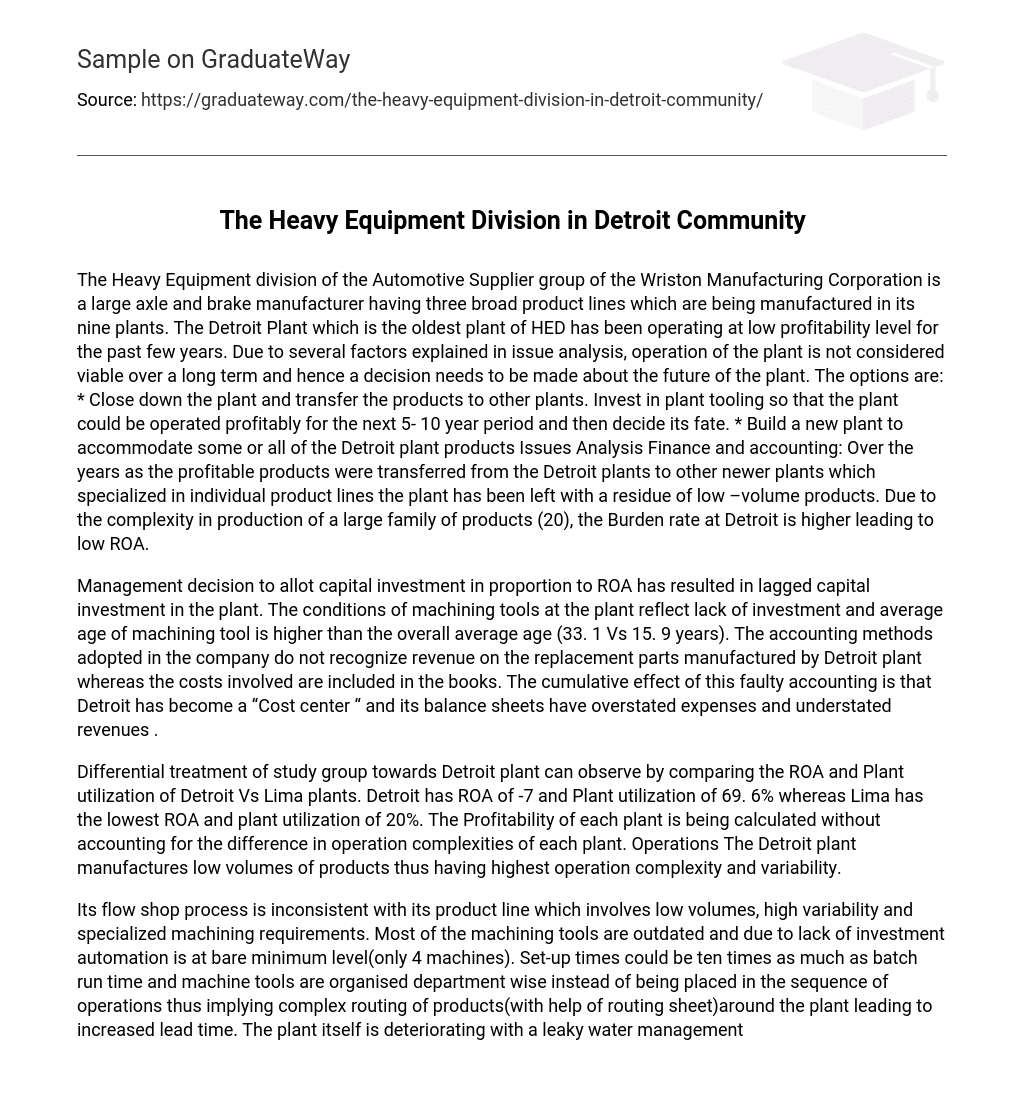The Heavy Equipment division of the Automotive Supplier group of the Wriston Manufacturing Corporation is a large axle and brake manufacturer having three broad product lines which are being manufactured in its nine plants. The Detroit Plant which is the oldest plant of HED has been operating at low profitability level for the past few years. Due to several factors explained in issue analysis, operation of the plant is not considered viable over a long term and hence a decision needs to be made about the future of the plant. The options are: * Close down the plant and transfer the products to other plants. Invest in plant tooling so that the plant could be operated profitably for the next 5- 10 year period and then decide its fate. * Build a new plant to accommodate some or all of the Detroit plant products Issues Analysis Finance and accounting: Over the years as the profitable products were transferred from the Detroit plants to other newer plants which specialized in individual product lines the plant has been left with a residue of low –volume products. Due to the complexity in production of a large family of products (20), the Burden rate at Detroit is higher leading to low ROA.
Management decision to allot capital investment in proportion to ROA has resulted in lagged capital investment in the plant. The conditions of machining tools at the plant reflect lack of investment and average age of machining tool is higher than the overall average age (33. 1 Vs 15. 9 years). The accounting methods adopted in the company do not recognize revenue on the replacement parts manufactured by Detroit plant whereas the costs involved are included in the books. The cumulative effect of this faulty accounting is that Detroit has become a “Cost center “ and its balance sheets have overstated expenses and understated revenues .
Differential treatment of study group towards Detroit plant can observe by comparing the ROA and Plant utilization of Detroit Vs Lima plants. Detroit has ROA of -7 and Plant utilization of 69. 6% whereas Lima has the lowest ROA and plant utilization of 20%. The Profitability of each plant is being calculated without accounting for the difference in operation complexities of each plant. Operations The Detroit plant manufactures low volumes of products thus having highest operation complexity and variability.
Its flow shop process is inconsistent with its product line which involves low volumes, high variability and specialized machining requirements. Most of the machining tools are outdated and due to lack of investment automation is at bare minimum level(only 4 machines). Set-up times could be ten times as much as batch run time and machine tools are organised department wise instead of being placed in the sequence of operations thus implying complex routing of products(with help of routing sheet)around the plant leading to increased lead time. The plant itself is deteriorating with a leaky water management system and faulty electrical system.
OBHR The employee morale is very low due to the gloomy work environment at the plant as well as lack of investment and lack of recognition of Detroit plants benefits. Absenteeism and turnover are deteriorating as the newer employees are not motivated enough by their wages implying they could be motivated by more interesting work . The allocation of each employee to a specialized machine limits the skills that each could gain and over long run boredom sets in. Loyalty to company is not necessarily a priority for new workers and polarization I of workforce into two groups adds complexity to the situation. Alternatives Analysis ) Closing the plant and transferring group 1 to Lancaster, Group 2 to Saginaw and dropping the group 3 may result in net cash out flow of $4Million in the year and NPV of $47 million (refer Appendix2). But complexity costs of handling the low volume products has not been included and specialized flow job in receiving plants would have to be modified to manufacture Detroit products. There are also issues involved with termination of people, public backlash from Detroit community and media and loss of potential sales. 2) Invest in plant tooling – This option has the lowest NPV hence is very unattractive option (Refer Appendix 3).
Also this is a short term option and at the end of 5-10 years we have to decide again. 3) Building a new plant- Assuming a 10% after-tax hurdle rate and that the new plant operates for at least 20 years the NPV of this option is highest ($47. 10 million). Refer appendix 3. During the period that the new plant is built the groups 1 and 2 can continue to be manufactured in the Detroit plant. The company is committed to its long term employees who may be retired by the end of the Detroit plants operations thus eliminating the necessity for employee-termination and the newer employees transferring to new plant.
The new plant should adopt job shop process and use highly automated machines which require minimum monitoring by employees. Newer employees who are motivated to work on new plant facilities guided by bunch of experienced employees will ensure productivity and efficiency in the new plant. Recommendations Considering the greater NPV of third option I recommend building a new plant. This option may lead to low cash flows during the transition period but in the long run is guaranteed to generate positive cash outflows.
Since HED has a long standing presence in Detroit community the new plant should be built in Detroit. The New plant should use job shop process and adopt Just in Time manufacturing and TQM techniques. Reduce the number of product families (reduce variability) and announce phase out of certain product families. During transition there may be some issues involved such as difficulty in replicating the product life cycle in job shop process model, Training requirements for workforce to get accustomed to new machinery.





